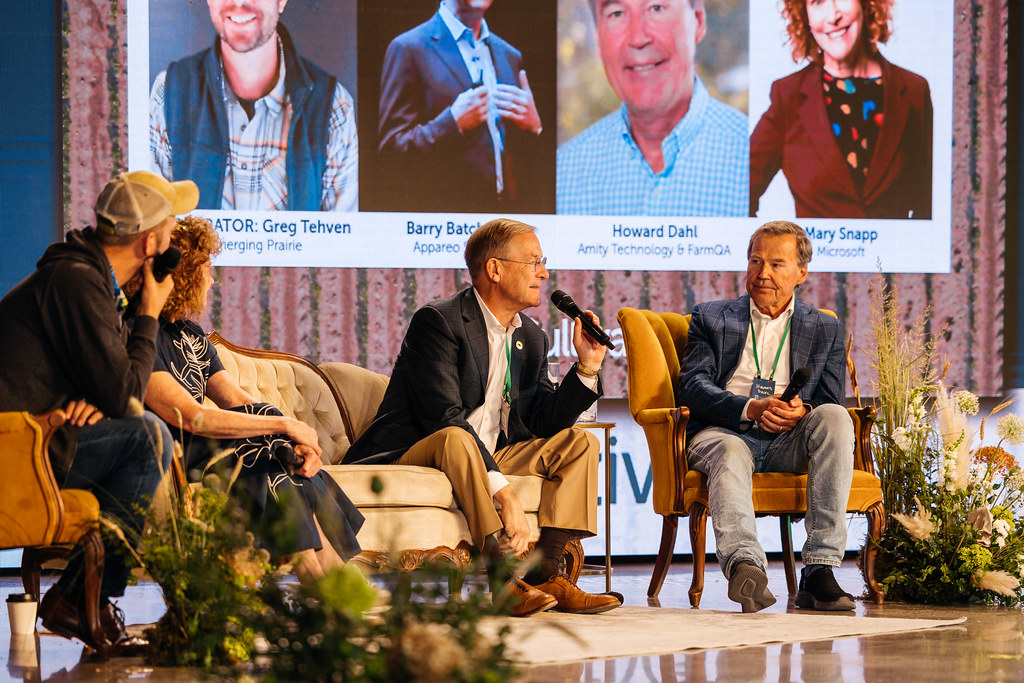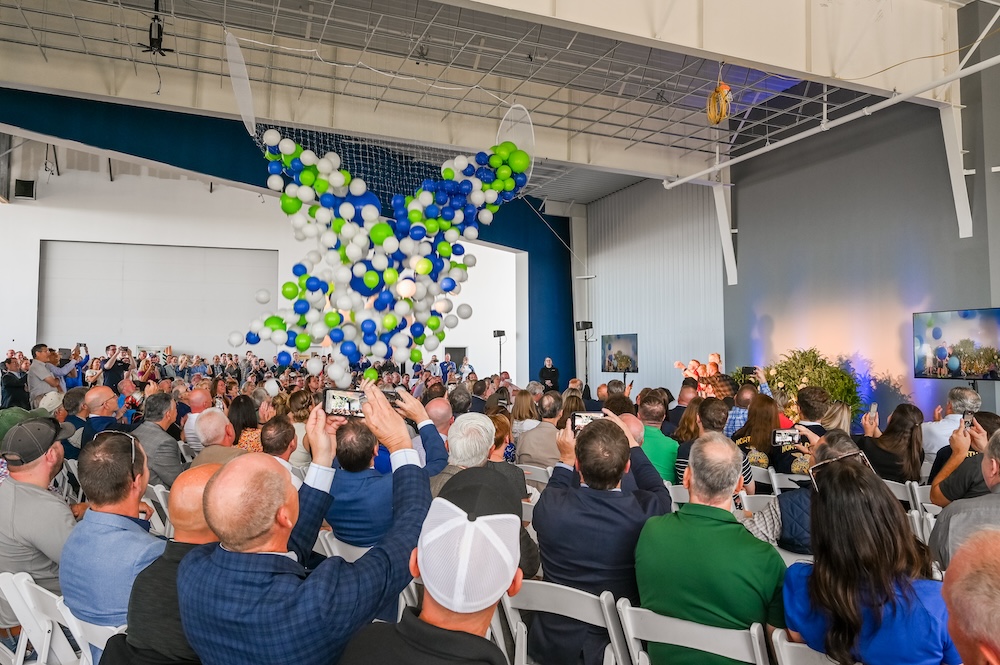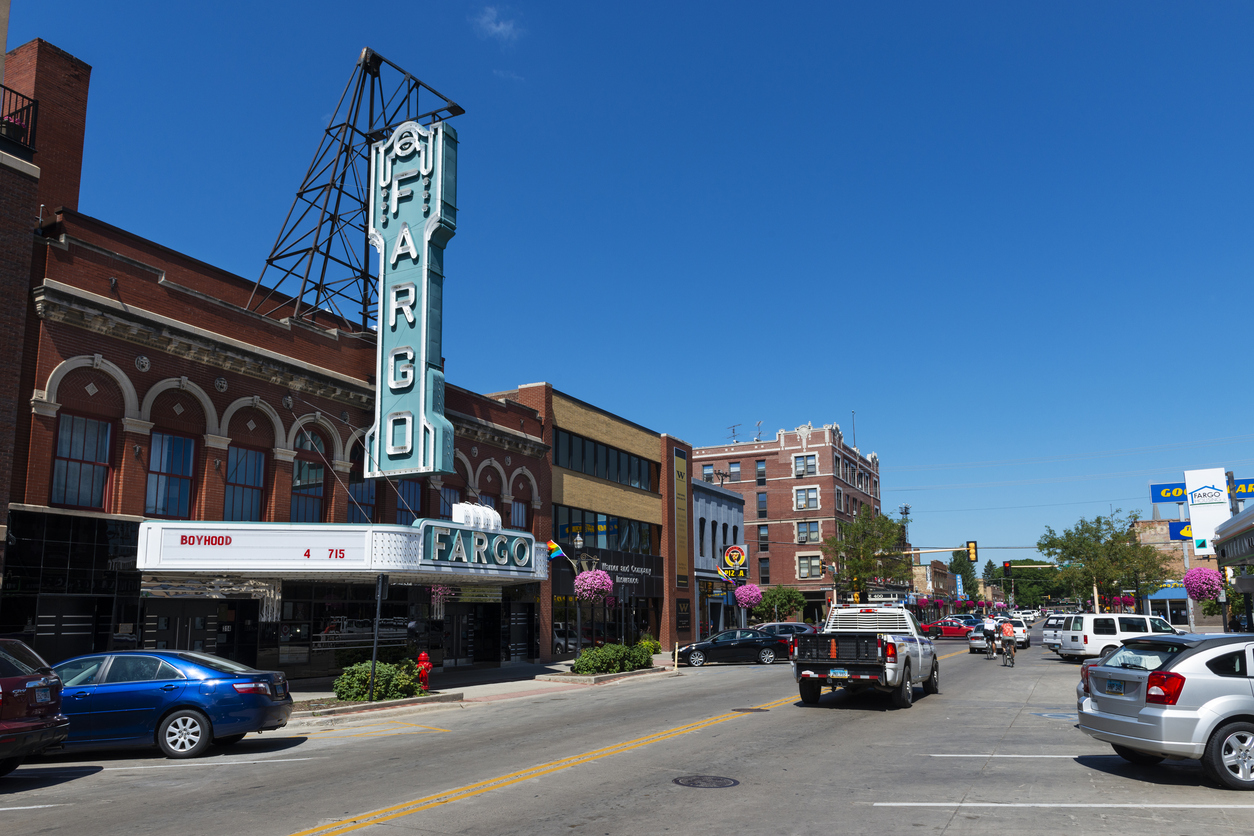In the second half of the nineteenth century, North Dakota and other parts of the US and Canada saw the rise of commercial wheat farming operations producing on a scale previously unheard of. Called “bonanza farms,” these enterprises worked thousands of acres at a time and utilized the latest machinery of the day, prompting one Atlantic writer in 1880 to ask whether bonanza farms were “destined to . . . work a revolution in the great economies of the farm.”
The largest and most well known of these was Dalrymple Farm, an 11,000-acre operation roughly 20 miles west of Fargo, North Dakota, just outside a small town called Casselton.
While the lifespan of Dalrymple and other bonanza farms was relatively short, the appetite for farm innovation has remained firmly entrenched in the Fargo region’s agriculture.
It was certainly evident on a morning in summer 2024 when the who’s-who of Fargo agtech gathered on some of that land around Casselton to celebrate the opening of the Grand Farm Innovation Shop, a 25,000-square-foot space dedicated to showcasing research and innovation in agriculture.
The Grand Farm initiative was born of the need to facilitate more collaboration and research between startups, growers, researchers and public- and private-sector stakeholders in order to address the most pressing needs in agriculture — first in North Dakota then globally. The 140-acre Grand Farm Innovation Campus outside Casselton provides offers land for field trials, and indoor space for classrooms and meetings.
“One of the challenges that’s unique to agtech startups is the innovation cycle,” says Andrew Jason, ecosystems director at nonprofit Emerging Prairie, which leads the Grand Farm initiative. “The business cycle takes so many years of testing and validation. Most startups just die because there’s so little funding.”
In 2024, Grand Farm has 31 field plots from 22 partners and 18 different organizations, including startups Pivot Bio and ClearLeaf, among others, as well as major corporates ADM and Anheuser-Busch. In June of this year, it launched a campus in Georgia.
“I think there’s an opportunity at Grand Farm to build an experimental farm of the future where [many] types of things are explored,” Howard Dahl, CEO of beet-harvesting tech company Amity Technology and a longtime agtech pioneer, said later in the week at another agtech event.
He envisioned, among other things, an operation powered by solar panels, making its own hydrogen in the winter months to burn in the summer months during farm operations.
Dahl along with multiple others attending Fargo’s agtech week this past June, suggested Grand Farm is just the next step in Fargo’s long history of agtech entrepreneurship.

Seeds of innovation
To understand the importance of Fargo’s role in agtech, “we have to go back in time a little bit,” says Ryan Raguse, cofounder of integrated workflow solution Bushel, which is headquartered in the city and serves the agricultural community. “There’s been a history of agriculture innovation inside of Fargo, and I would call that the seed.”
Bonanza farms were one thing. Agtech in Fargo as we know it, he suggests, kicked off in the mid-twentieth century with the emergence of equipment manufacturers Bobcat, which developed the world’s first skid-steer loader, and Steiger Tractor, widely credited with putting the first computer chip on a tractor courtesy of in-house engineer Barry Batcheller.
Batcheller, who’s something of an entrepreneurial legend in agtech, would go on to found Phoenix International, a hardware/software manufacturing company acquired by John Deere in 1999. Dahl, who’s the grandson of E.G. Melroe, founder of the Melroe company that created the aforementioned Bobacat loader, also kicked off his career in agriculture in the mid century.
Software came into play in the 1980s with the emergence of Great Plains Software, acquired by Microsoft for $1.1 billion in 2001. The latter has kept a foot in Fargo, where it still operates a campus. In 2018, the company invested $1.5 million into Grand Farm.
“If you look at the history of this region, you see a history of innovation in ag technology,” explains Greg Lardy, VP of agriculture at North Dakota State University. “You have the spirit of innovation that’s been happening for decades, and you have a high level of entrepreneurism, in part because the region had to be entrepreneurial for people to just get by. When you start bringing those two things together, you get all kinds of other things, and people start to notice.”
“Among the people and the companies [in Fargo] — the formation of Bobcat, Phoenix International, Steiger tractor sold the very first computer chip on the tractor — there’s this pioneering spirit of mechanization of agriculture,” says Emerging Prairie cofounder Greg Tehven.
Culture, particularly a generational mindset to innovation, is coupled with this history, he adds.
“I hear a lot of people [in Fargo agtech] talk about how their grandpa or grandma would have been proud, and I think there’s also these unwritten rules around trust. It’s just how the local communities operate here.”

‘I could pick up the phone and call anyone I wanted to’
“It’s not one big thing that gives Fargo the privilege to say it’s important to agtech; it’s been 1,000 things over the last 30 or 50 years,” says Raguse.
Raguse landed in Fargo some 15 years ago. “I was interested in entrepreneurial things. I just never left, and it was truly the people who kept me here,” he adds.
One of those folks was Jake Joraanstad, with whom he cofounded Bushel in 2017. Bushel has made a name for itself developing software that improves “the messy middle” of agriculture — the agribusinesses, co-ops, retailers and large grain companies.
Both Raguse and Joraanstad credit much of the success of their company and others to the accessible nature of capital, government and technology in Fargo for the agtech ecosystem.
“I wanted to start a business, I wanted to do these different things, and I could literally pick up the phone and call anybody I wanted to,” says Raguse. “I could get hold of Howard Dahl if I wanted to, I could spend time with basically any business owner.”
Joraanstad also points to the ease in testing and deploying certain technologies compared to other places in the US.
For example, when auto-steer came to tractors in the late ’90s, the need for RTK networks emerged, he says. Rather than requiring North Dakota farmers to build towers on their own fields, “A conglomerate of the biggest tractor dealers in the country now, and in North Dakota at the time, agreed to fund the rural tower network which went entirely down the Red River Valley.”
“They built these towers with RTK receivers on them so that farmers didn’t have to individually build their tower networks, they could use a public infrastructure. Now, every farmer has the most accurate GPS technology available and it’s for free,” he adds.
North Dakota’s policies around autonomous machines may also give places like Grand Farm an edge when it comes to testing new technologies.
“You can test autonomy with relative ease compared to other states. One of the biggest challenges farmers have said [about autonomous vehicles] is, ‘it’s great when it’s in my field, but I have to get it to my field and it can’t drive itself.'”
In response, the North Dakota government is designating certain highways as “autonomy testing highways.”
“We can run four CHS trucks down the highway with only one driver and the other three trucks are following and it’s legal to test in our state,” says Joraanstad.
It’s similar with drones, which in North Dakota can be flown beyond line of sight. North Dakota is one of seven FAA test sites that conducts research on uncrewed aircraft systems, which Joraanstad says makes the idea of drones more commercially viable for agriculture.

‘We have sufficient capital to support the ecosystem’
That Fargo has unique opportunities capital wise is a view shared across the board.
“The state has a wide portfolio of programs that have created access to capital for entrepreneurs and business owners,” explains Kodee Furst, director at 50 South Capital. “The Bank of North Dakota, Clean Sustainable Energy Authority, North Dakota Department of Agriculture, North Dakota Department of Commerce, among others, offer non-dilutive capital for companies that are starting and growing here.”
Among those, the Bank of North Dakota stands out as the only state-owned bank in the country. The idea behind it is to improve access to credit, partner with local private banks to assist with things like lending capacity, and contribute revenues to the state government. Other US states have examined the model in the past and considered implementing it within their own borders.
Furst also highlights the North Dakota Growth Fund (NDGF), an “in-state private equity program” created in 2021.
Also referred to as North Dakota’s sovereign wealth fund, NDGF “was created to further advance innovation and private markets investments in North Dakota by seeking investments that provide strong risk-adjusted returns and support the growing entrepreneurial ecosystem in the State,” says Furst. It invests a portion of the Legacy Fund into North Dakota companies through private equity.
“They want to be generational [with this fund],” says Joraanstad. “They call it ‘the Legacy Fund’ for a reason. They said, ‘Let’s carve out a subset of these dollars to invest in businesses connected to North Dakota, whether tech, infrastructure or something else.'”
He adds that it’s “relatively easy” for an entrepreneur to arrive in Fargo and access capital. “An entrepreneur can come here and access tens of thousands in capital, hundreds of thousands in financing, and millions in investment ,and [be] incentivized to do so. We agree the more the merry in terms of people coming here because we have sufficient capital to support the ecosystem.”

A ‘flywheel that’s beginning to spin faster’
How can the region maintain this business-friendly, community first environment as continues to grow and attract attention?
Raguse likens it to running a company.
“As long as you have that passion and that plan, those people can keep working and building and making more opportunities,” he says. “As you scale, keeping the culture gets to be more and more challenging. You have to be more intentional, and if you don’t, you end up getting these microcosms of people splitting up in different ways.”
“What you’re seeing here is just the natural progression of what’s been here for years, but now because of advances in software, advances in equipment and artificial intelligence, it’s a flywheel that’s beginning to spin and spin faster,” says Lardy.
“I don’t see [the collaborative] spirit going away,” he adds. “In fact, I think we’ve probably become more collaborative as this momentum occurs.”




